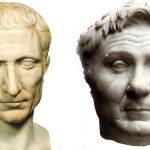Originally, the Roman religion was animistic and abstract. Finally, Etruscan influences, during the kingdom, caused the Roman deities to become anthropomorphic. From the Etruscans, the custom of setting up temples was also accepted. On Capitol Hill, a shrine was erected, in which statues of the three most important Etruscan gods were found: Tinii – identified with Jupiter, Uni – with Juno and Minerva. These deities created the so-called the Capitoline Triad, replacing the Latin Triad: Jupiter, Mars and Quirin.
In general, ancient Romans believed that every area of their activity is filled with good and evil spirits, which should be appeased by gifts and sacrifices. The gods were concerned with fear, and piety (pietas) consisted mainly in observing rituals and all cult rules. Any faults or omissions were to be met with severe punishment by the deities.
As an agricultural society, the ancient Romans created an extremely large number of deities who look after nature and supervise even the smallest cultivation process. For example, when cultivating, Vervactor, Redarator and Obarator were prayed. During sacrifice, the sacrifices were made to Serculinius, during sowing – Saturnus, while the grain was seized – goddess Seia, and during the harvest period – the goddess Segetia. The cereal ripened with the help of Lacturus, and flourished thanks to Flora; the harvest was in turn the domain of Messis. The Romans also had their guardians against all adversities. Runcinator was protecting before the weeds, and Robigo before grain rust.







